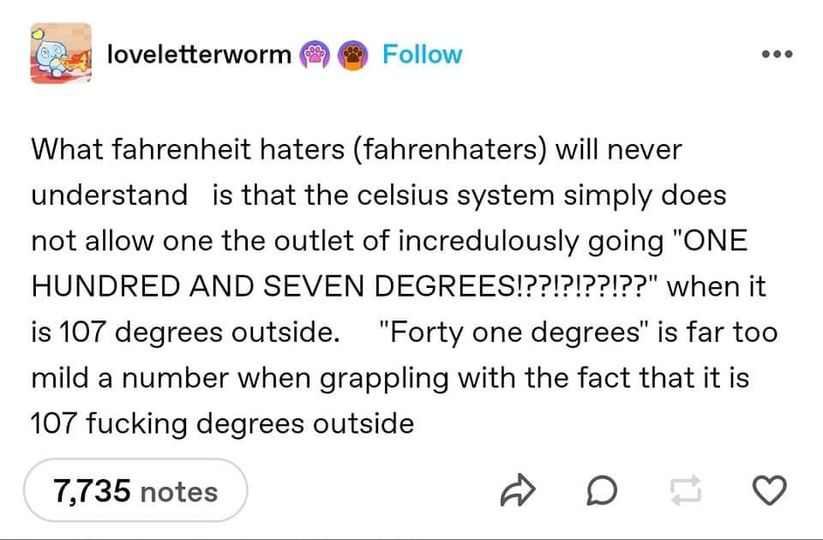this post was submitted on 09 Sep 2024
1213 points (92.4% liked)
Science Memes
11523 readers
1232 users here now
Welcome to c/science_memes @ Mander.xyz!
A place for majestic STEMLORD peacocking, as well as memes about the realities of working in a lab.

Rules
- Don't throw mud. Behave like an intellectual and remember the human.
- Keep it rooted (on topic).
- No spam.
- Infographics welcome, get schooled.
This is a science community. We use the Dawkins definition of meme.
Research Committee
Other Mander Communities
Science and Research
Biology and Life Sciences
- [email protected]
- [email protected]
- [email protected]
- [email protected]
- [email protected]
- [email protected]
- [email protected]
- [email protected]
- [email protected]
- [email protected]
- [email protected]
- [email protected]
- [email protected]
- [email protected]
- [email protected]
- [email protected]
- [email protected]
- [email protected]
- [email protected]
- [email protected]
- [email protected]
- [email protected]
- [email protected]
- [email protected]
- !reptiles and [email protected]
Physical Sciences
- [email protected]
- [email protected]
- [email protected]
- [email protected]
- [email protected]
- [email protected]
- [email protected]
- [email protected]
- [email protected]
Humanities and Social Sciences
Practical and Applied Sciences
- !exercise-and [email protected]
- [email protected]
- !self [email protected]
- [email protected]
- [email protected]
- [email protected]
Memes
Miscellaneous
founded 2 years ago
MODERATORS
you are viewing a single comment's thread
view the rest of the comments
view the rest of the comments

only if you grow up with fahrenheit.
100F was defined as the human body temperature (The guy they used had a cold or something so it's off by a degree and a half.)
That's useful for perception of heat. When the dry bulb gets above 100F, wind only cools you down by sweat evaporation, and when the wet bulb gets above 100F, even that can’t cool you down, and you will die if you don’t get to a cooler or drier environment.
This is more intuitive than 36.5C.
what Fahrenheit used for his endpoints was 1) the melting point of a brine mixture that he didn't write down the ratio of, and 2) his wife's armpit.
those "bulb" things is something i only ever hear of from americans. it's never used here.
and I fail to see how two numbers are somehow differently intuitive. they are just numbers. also, 36.5 is too low. it's pretty much 37.0 now, because average body temp has interestingly enough shifted since he took those measurements.
What does Europe use for apparent temperature measurement then? Just humidity and not evaporation?
temperature, wind speed and direction, and humidity are given separately. regular news report style forecasts don't give humidity at all.
So you're saying that 0 and 100 aren't intuitively obvious? I find that really strange when it's doing a better job keeping to base 10 than the metric system in this particular use case.
the numbers may be, but if you asked me to tell you what they feel like i would have to convert them to celsius first. where i live temperatures are generally between -30 and +30, and i could tell you in an instant what I would wear for a given temperature in that range. 50F though? no clue. since it's right between 0 and 100 i guess it would be just right, temperature wise, so t-shirt and long pants?
Can you remember that at temperatures near 0F and 100F, you need to take special precautions when going outside? The rest is a matter of getting used to what the numbers mean, but those are very intuitive danger points.
-18 is such an arbitrary place for "special precautions". at 0, I know to start driving more carefully since the roads ice up. at -15, i know to wear long johns. at +15, i know to start using a thinner jacket. at -30, i know to use a thick hat and wax on my cheeks to prevent the blood vessels from rupturing. at +30, I know to use a large hat and sun cream on my cheeks to prevent them from burning.
When it comes to a single number on a scale, whatever you grew up with will be more "obvious". 100F doesn't give me any more information than 38C does. The whole "base 10" thing only matters if you are actually doing some math to that number.
Base 10 makes it much easier to remember.
When was the last time you did math related to temperature?
For day to day use, it's just a single number, no one is doing any conversions, etc, with the number. That was my point. There's nothing to remember. Do you forget what 72F feels like? Do you have to scale it in your head?
base 10 is literally just 0-9 so yeah, everyone remembers that.
scaling based on the base 10 figure makes conversions easier, so there's that.
For Celsius, 0 is freezing cold and 100 is boiling hot - that's intuitive too.
I have literally never felt 0°F in my life and couldn't tell you how cold it is, just that it's very cold. I believe everyone has a rough understanding how 0°C and 100°C feel though.
No, they're not. I couldn't tell what those numbers mean even if you asked, but I can tell what 0°C outside feels, and what 100°C sauna feels. I can also tell that 21°C is a nice ambient temperature for chilling, and 15-20°C is ideal for most outdoor sports.
Yeah sure those are not necessarily nice round numbers, but I've used the scale all my life so it's intuitive to me, same as the Fahrentrash is intuitive to you
They aren't. And fahrenheit is not a 0-100 scale. It is just the scale you picked out of it in order to make some kind of sense out of the non-intuitive system which it is.